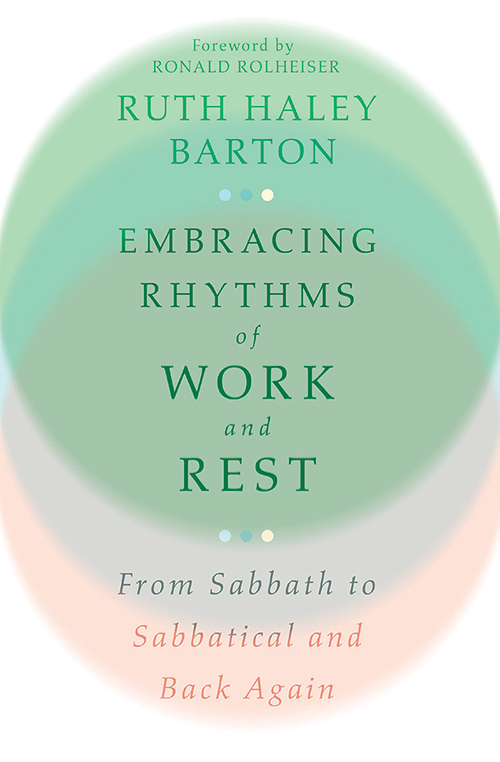
Embracing Rhythms of Work and Rest: From Sabbath to Sabbatical and Back Again
Reviewed by William Shetter
November 1, 2022
By Ruth Haley Barton. InterVarsity Press, 2022. 264 pages. $25/hardcover; $24.99/eBook.
The story is familiar to all of us. Following six days of creation, on the seventh day God rested, formalized to Moses in the commandment “Remember the Sabbath day, to keep it holy.” Its importance is evidenced by the fact that this commandment stands as the bridge between the first three that focus on God, and the rest about behavior toward others. Ruth Haley Barton is challenging us here to consider how seriously we take this principle beyond the habit of worshiping on Sunday. The Sabbath is God’s gift, “not just a weekly sabbath day, but also daily sabbath moments cultivated in solitude and silence, and sabbatical seasons for letting the soil of [the] soul lie fallow.”
Barton brings into the discussion ideas from Tilden Edwards’s Sabbath Time, Rabbi Abraham Heschel’s The Sabbath, and especially Walter Brueggemann’s Sabbath as Resistance: Saying No to the Culture of Now.
The second half of the book, on “sabbatical seasons,” is primarily Barton’s own thought, founded on the injunction in Leviticus that cropland is to lie fallow every seventh year. Barton is founder and president of the Transforming Center, a ministry supporting and strengthening the work of pastors and other leaders, and this is clearly the purpose and orientation of her book. Because the work centers on spiritual “renewal leave” for church leaders, Barton is careful to distinguish this from the familiar academic “study leave,” intended to enable learning and writing. Perhaps what she describes could be better called a “Sabbath year.”
Much of the second half of the book is devoted to the many considerations and details involved in awarding a pastor or other leader a sabbatical year. Her own and others’ stories illustrate the long and complex process; admittedly, these are sometimes a bit tiresomely detailed. Preparation includes assurance of community support; planning for the year; the reentry into full-time service; and the clarification of goals, both practical and spiritual. Barton notes in passing that a year away can be a lesson in humility, allowing one to realize one is not indispensable after all. The author adds a four-page liturgy of her own in the form of responsive readings from the community for the one receiving the sabbatical: “A Blessing for Sabbatical Time.” In appendices, she adds a Sabbath worksheet and a guide on becoming a Sabbath community.
Even though Friends speak readily and often of ministries, most readers will not readily identify with ministry meant as the work of the clerical audience she is addressing. Fortunately, the first part of the book contains a rich store of thought about how Sabbath is for everyone. She uses her own story to illustrate how one’s understanding of Sabbath can grow, what she calls her “sabbath journey.” Like many of us who have busy lives, she ignored observing Sabbath when it was inconvenient. There was a time when Sundays were different from all other days, a quiet withdrawal upheld by the general culture, including the nonreligious. All supported a weekly rhythm that is the true beauty of the Sabbath experience, at the same time showing that its essence is a communal one. Ultimately she resisted her modern culture’s seeming insistence that one be always “plugged in,” and came to recognize Sabbath as a gift for unplugging: “a way of being in time that is open and receptive, restful and replenishing.” More than that, it is “a quality-of-time way of being that is possible anytime, anywhere.” In other words, there can be pauses during the day, week, or at more extended intervals. We need to step completely out of our usual activity, so it is important not to “cheat” a bit (with, for instance, the lure of technology); we are clearly only cheating ourselves.
The reason why the commandment calls the Sabbath “holy” is that it rests on the identity of the self that is not based on what we do but what we are. For Barton, its true holiness is described best in Isaiah 30:15, in words that are not even intended to describe the Sabbath: “In returning and rest you shall be saved; in quietness and in trust shall be your strength.” This is the reason for the reference to “sabbath,” not to “the sabbath”: not the day itself but the underlying call to rest. When all is said and done, the Sabbath commandment is at heart an intensely practical, sensible rhythm of rest for everyone.
The book concludes with a brief excerpt from one of Wendell Berry’s many Sabbath poems, beginning with the words “The mind that comes to rest . . .”
William Shetter is a member of Bloomington (Ind.) Meeting. His long retirement is proving to be the blessing of an extended Sabbath.



Comments on Friendsjournal.org may be used in the Forum of the print magazine and may be edited for length and clarity.